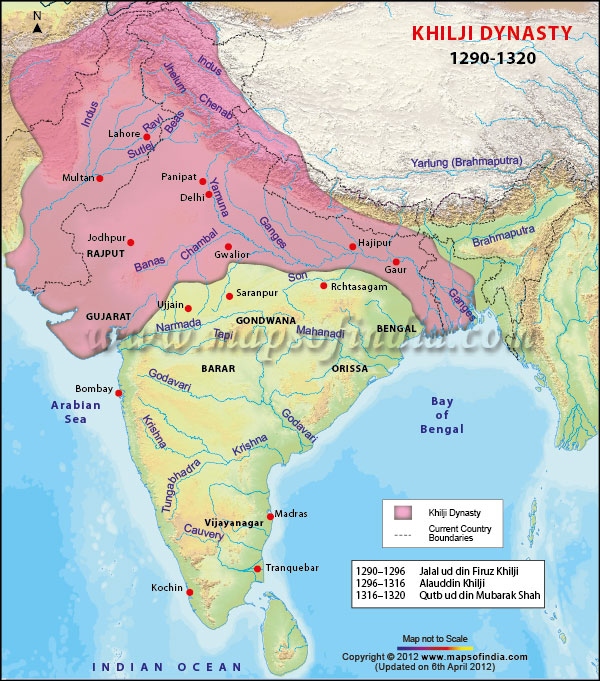Follow Us On:
Jalal-ud-din Khilji overthrew Balban’s successors and founded the Khilji Dynasty, which ruled large parts of South Asia between 1290 and 1320. That was the second dynasty to rule the Delhi Sultanate of India. “The Khilji dynasty was named after a village in Afghanistan. Some historians believe that they were Afghans, but Bharani and Wolse Haig explain in their accounts that the rulers from this dynasty who came to India, though they had temporarily settled in Afghanistan, were originally Turkic”.The Khiljis were a Central Asian Turkic dynasty but having been long domiciled in Afghanistan, and adopted some Afghan habits and customs. They were treated as Afghans in Delhi Court”. The three sultans of the Khalji dynasty were noted by historians for their faithlessness and ferocity. To some extent, the Khilji usurpation was a move toward the recognition of a shifting balance of power attributable to the developments outside the territory of the Delhi Sultanate (in Central Asia and Iran) and to the changes which followed the establishment of Turkic rule in northern India. The court languages of the Khiljis were Persian, followed by Arabic, their native Turkoman language and some northern-Indian dialects. Although it was not their native language, the Khilji sultans encouraged the use of Persian. This co-existence of different languages gave birth to an early form of Urdu. According to Ibn Batuta, the Khiljis encouraged conversion to Islam by making it customary to have the convert presented to the sultan (who would place a robe on him and reward him with gold bracelets). During Ikhtiyar Uddin Bakhtiyar Khilji’s control of Bengal, Muslim missionaries in India achieved their greatest success in the number of converts to Islam.
The founder of the Khalji Dynasty in South Asia, Malik Firuz, was originally the Ariz-i-Mumalik appointed by Kaiqubad during the days of decline of the Slave Dynasty. He took advantage of the political vacuum that was created due to the incompetence of the successors of Balban. To occupy the throne, he only had to remove the infant Sultan Kaimurs. On June 13 1290, Malik Firuz ascended the throne of Delhi as Jalal-ud-din Firuz Shah. Khaljis were basically Central Asians but had lived in Afghanistan for so long that they had become different from the Turks in terms of customs and manners. Thus the coming of Khaljis to power was more than a dynastic change. As majority of the Muslim population of Delhi was Turk, the arrival of a Khalji ruler was not much welcomed. Yet Jalal-ud-din managed to win the hearts of the people through his mildness and generosity. He retained most of the officers holding key positions in the Slave Dynasty. His own nephew and son-in-law Alauddin Khalji, killed Jalal-ud-din and took over as the new ruler. From 1296 AD to 1316 AD Alauddin Khilji dominated the Delhi sultanate with many courageous achievements. Soon after becoming the Sultan of Delhi Alauddin Khilji in 1297 AD went out to win over the various parts of Gujarat state Ala- ud-din also was able to implement startling economic reforms, although their effects were probably restricted to Delhi and the 100 mile radius around it. Nevertheless this was truly creditable for he achieved what modern governments in India have not completely achieved. Ala-ud-din re-organized the market so that there were fixed prices which were affordable, he developed warehousing facilities to ensure ready stock of goods, the government entered the business of transportation and provided facilities for the swift movement of goods. Alauddin’s reign is marked by innovative administrative and revenue reforms, market control regulations and a whirlwind period of conquests. It is considered the golden period of the Khalji rule. However, before the death of Alauddin, his house was divided into two camps. This resulted in the ultimate collapse of the Khalji dynasty. He died on January 1316 due to an acute health condition.
The third and last ruler of the Khilji dynasty in India was Qutb-ud-Din Mubarak Shah. He was the weakest ruler of all and during his reign, all taxes and penalties were abolished. He released all prisoners of war who were captured after waging gruesome battles. He was ultimately murdered by Khusru Khan and this ended the Khilji dynasty in India.

